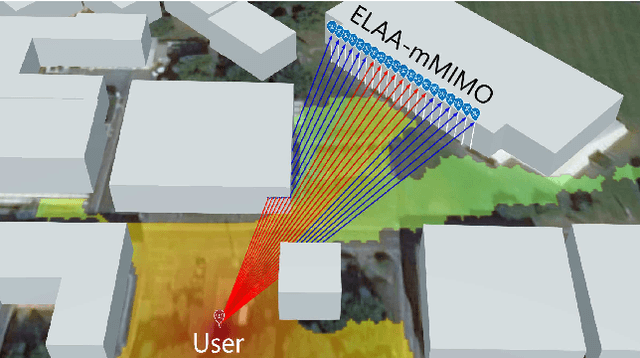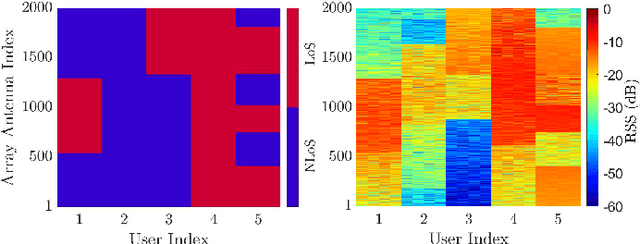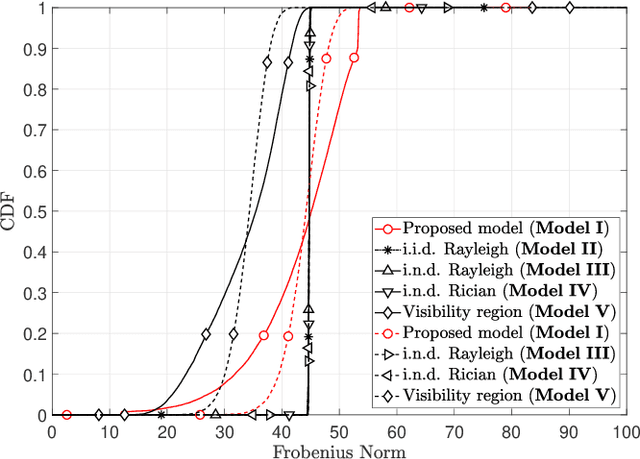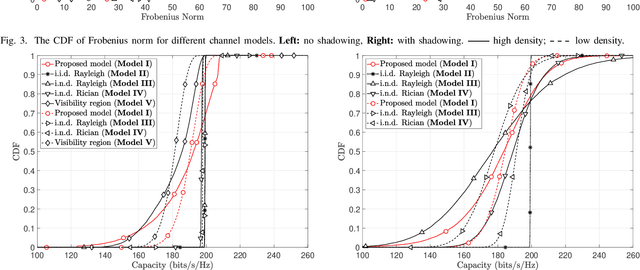Jiuyu Liu
Fast Iterative ELAA-MIMO Detection Exploiting Static Channel Components
Aug 22, 2024Abstract:Extremely large aperture array (ELAA) is a promising multiple-input multiple-output (MIMO) technique for next generation mobile networks. In this paper, we propose two novel approaches to accelerate the convergence of current iterative MIMO detectors in ELAA channels. Our approaches exploit the static components of the ELAA channel, which include line of sight (LoS) paths and deterministic non-LoS (NLoS) components due to channel hardening effects. This paper proposes novel convergence acceleration techniques for fast iterative ELAA-MIMO detection by leveraging the static channel component, including the LoS paths and deterministic NLoS components that arise due to channel hardening. Specifically, these static channel components are utilized in two ways: as preconditioning matrices for general iterative algorithms, and as initialization for quasi-Newton (QN) methods. Simulation results show that the proposed approaches converge significantly faster compared to current iterative MIMO detectors, especially under strong LoS conditions with high Rician K-factor. Furthermore, QN methods with the proposed initialization matrix consistently achieve the best convergence performance while maintaining low complexity.
Accelerating Iteratively Linear Detectors in Multi-User (ELAA-)MIMO Systems with UW-SVD
Aug 16, 2024Abstract:Current iterative multiple-input multiple-output (MIMO) detectors suffer from slow convergence when the wireless channel is ill-conditioned. The ill-conditioning is mainly caused by spatial correlation between channel columns corresponding to the same user equipment, known as intra-user interference. In addition, in the emerging MIMO systems using an extremely large aperture array (ELAA), spatial non-stationarity can make the channel even more ill-conditioned. In this paper, user-wise singular value decomposition (UW-SVD) is proposed to accelerate the convergence of iterative MIMO detectors. Its basic principle is to perform SVD on each user's sub-channel matrix to eliminate intra-user interference. Then, the MIMO signal model is effectively transformed into an equivalent signal (e-signal) model, comprising an e-channel matrix and an e-signal vector. Existing iterative algorithms can be used to recover the e-signal vector, which undergoes post-processing to obtain the signal vector. It is proven that the e-channel matrix is better conditioned than the original MIMO channel for spatially correlated (ELAA-)MIMO channels. This implies that UW-SVD can accelerate current iterative algorithms, which is confirmed by our simulation results. Specifically, it can speed up convergence by up to 10 times in both uncoded and coded systems.
Wi-Fi Beyond Communications: Experimental Evaluation of Respiration Monitoring and Motion Detection Using COTS Devices
Jul 06, 2024Abstract:Wi-Fi sensing has become an attractive option for non-invasive monitoring of human activities and vital signs. This paper explores the feasibility of using state-of-the-art commercial off-the-shelf (COTS) devices for Wi-Fi sensing applications, particularly respiration monitoring and motion detection. We utilize the Intel AX210 network interface card (NIC) to transmit Wi-Fi signals in both 2.4 GHz and 6 GHz frequency bands. Our experiments rely on channel frequency response (CFR) and received signal strength indicator (RSSI) data, which are processed using a moving average algorithm to extract human behavior patterns. The experimental results demonstrate the effectiveness of our approach in capturing and representing human respiration and motion patterns. Furthermore, we compare the performance of Wi-Fi sensing across different frequency bands, highlighting the advantages of using higher frequencies for improved sensitivity and clarity. Our findings showcase the practicality of using COTS devices for Wi-Fi sensing and lay the groundwork for the development of non-invasive, contactless sensing systems. These systems have potential applications in various fields, including healthcare, smart homes, and Metaverse.
Near-Field Fading Channel Modeling for ELAAs: From Communication to ISAC
Jan 30, 2024Abstract:Extremely large aperture array (ELAA) is anticipated to serve as a pivotal feature of future multiple-input multiple-output (MIMO) systems in 6G. Near-field (NF) fading channel models are essential for reliable link-level simulation and ELAA system design. In this article, we propose a framework designed to generate NF fading channels for both communication and integrated sensing and communication (ISAC) applications. The framework allows a mixed of line of sight (LoS) and non-LoS (NLoS) links. It also considers spherical wave model and spatially non-stationary shadow fading. Based on this framework, we propose a three-dimensional (3D) fading channel model for ELAA systems deployed with a uniform rectangular array (URA). It can capture the impact of sensing object for ISAC applications. Moreover, all parameters involved in the framework are based on specifications or measurements from the 3rd Generation Partnership Project (3GPP) documents. Therefore, the proposed framework and channel model have the potential to contribute to the standard in various aspects, including ISAC, extra-large (XL-) MIMO, and reconfigurable intelligent surface (RIS) aided MIMO systems. Finally, future directions for ELAA are presented, including not only NF channel modeling but also the design of next-generation transceivers.
Near and Far Field Model Mismatch: Implications on 6G Communications, Localization, and Sensing
Oct 10, 2023Abstract:The upcoming 6G technology is expected to operate in near-field (NF) radiating conditions thanks to high-frequency and electrically large antenna arrays. While several studies have already addressed this possibility, it is worth noting that NF models introduce heightened complexity, the justification for which is not always evident in terms of performance improvements. Therefore, this paper delves into the implications of the disparity between NF and far-field (FF) models concerning communication, localization, and sensing systems. Such disparity might lead to a degradation of performance metrics like localization accuracy, sensing reliability, and communication efficiency. Through an exploration of the effects arising from the mismatches between NF and FF models, this study seeks to illuminate the challenges confronting system designers and offer valuable insights into the balance between model accuracy, which typically requires a high complexity and achievable performance. To substantiate our perspective, we also incorporate a numerical performance assessment confirming the repercussions of the mismatch between NF and FF models.
Alternative Normalized-Preconditioning for Scalable Iterative Large-MIMO Detection
Aug 22, 2023Abstract:Signal detection in large multiple-input multiple-output (large-MIMO) systems presents greater challenges compared to conventional massive-MIMO for two primary reasons. First, large-MIMO systems lack favorable propagation conditions as they do not require a substantially greater number of service antennas relative to user antennas. Second, the wireless channel may exhibit spatial non-stationarity when an extremely large aperture array (ELAA) is deployed in a large-MIMO system. In this paper, we propose a scalable iterative large-MIMO detector named ANPID, which simultaneously delivers 1) close to maximum-likelihood detection performance, 2) low computational-complexity (i.e., square-order of transmit antennas), 3) fast convergence, and 4) robustness to the spatial non-stationarity in ELAA channels. ANPID incorporates a damping demodulation step into stationary iterative (SI) methods and alternates between two distinct demodulated SI methods. Simulation results demonstrate that ANPID fulfills all the four features concurrently and outperforms existing low-complexity MIMO detectors, especially in highly-loaded large MIMO systems.
Leveraging User-Wise SVD for Accelerated Convergence in Iterative ELAA-MIMO Detections
Jun 21, 2023Abstract:Numerous low-complexity iterative algorithms have been proposed to offer the performance of linear multiple-input multiple-output (MIMO) detectors bypassing the channel matrix inverse. These algorithms exhibit fast convergence in well-conditioned MIMO channels. However, in the emerging MIMO paradigm utilizing extremely large aperture arrays (ELAA), the wireless channel may become ill-conditioned because of spatial non-stationarity, which results in a considerably slower convergence rate for these algorithms. In this paper, we propose a novel ELAA-MIMO detection scheme that leverages user-wise singular value decomposition (UW-SVD) to accelerate the convergence of these iterative algorithms. By applying UW-SVD, the MIMO signal model can be converted into an equivalent form featuring a better-conditioned transfer function. Then, existing iterative algorithms can be utilized to recover the transmitted signal from the converted signal model with accelerated convergence towards zero-forcing performance. Our simulation results indicate that proposed UW-SVD scheme can significantly accelerate the convergence of the iterative algorithms in spatially non-stationary ELAA channels. Moreover, the computational complexity of the UW-SVD is comparatively minor in relation to the inherent complexity of the iterative algorithms.
A Non-Stationary Channel Model with Correlated NLoS/LoS States for ELAA-mMIMO
Aug 18, 2021



Abstract:In this paper, a novel spatially non-stationary channel model is proposed for link-level computer simulations of massive multiple-input multiple-output (mMIMO) with extremely large aperture array (ELAA). The proposed channel model allows a mix of non-line-of-sight (NLoS) and LoS links between a user and service antennas. The NLoS/LoS state of each link is characterized by a binary random variable, which obeys a correlated Bernoulli distribution. The correlation is described in the form of an exponentially decaying window. In addition, the proposed model incorporates shadowing effects which are non-identical for NLoS and LoS states. It is demonstrated, through computer emulation, that the proposed model can capture almost all spatially non-stationary fading behaviors of the ELAA-mMIMO channel. Moreover, it has a low implementational complexity. With the proposed channel model, Monte-Carlo simulations are carried out to evaluate the channel capacity of ELAA-mMIMO. It is shown that the ELAA-mMIMO channel capacity has considerably different stochastic characteristics from the conventional mMIMO due to the presence of channel spatial non-stationarity.
 Add to Chrome
Add to Chrome Add to Firefox
Add to Firefox Add to Edge
Add to Edge